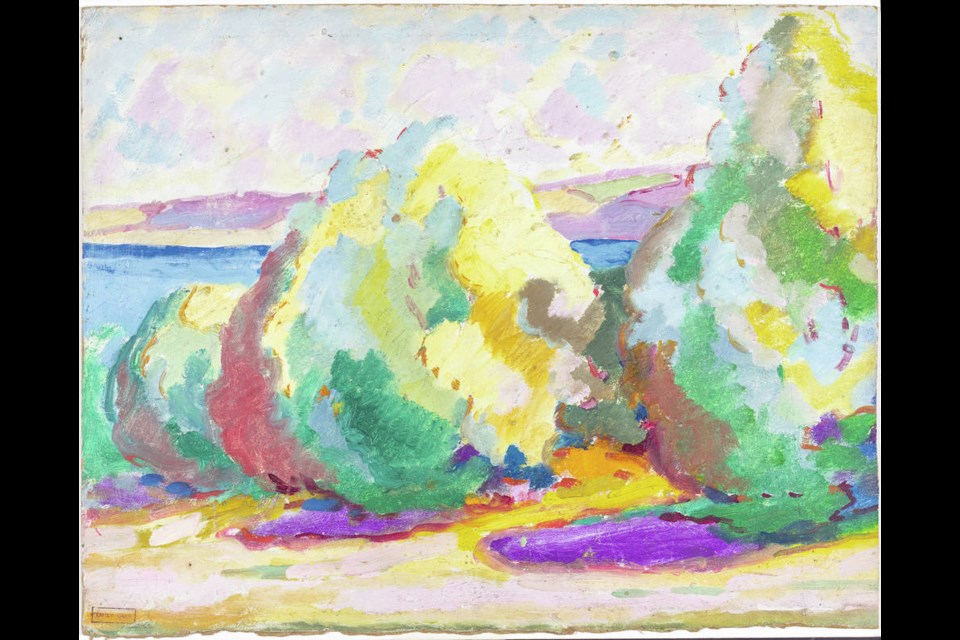Emily Carr is best known for her wild, vivid paintings of the B.C. coast. But she wouldn’t be the artist we know today if it wasn’t for the time she spent immersed in the modernist and post-impressionist art movements in France in the early part of the last century, says the curator of a new exhibit at the Royal B.C. Museum.
Carr spent nearly a year and a half in France, studying at the Académie Colarossi in Paris, before returning to B.C. in 1911. Carr called what she learned in France “fresh seeing,” as it opened the door to new ways of working, altering the course of her career.
The new exhibit, Emily Carr: Fresh Seeing – French Modernism and the West Coast, chronicles her post-France mindset and follows the trajectory that would make the Victoria native one of the most important artists in Canadian history.
“[Carr] said at several times throughout her life that she could not have gone back to the old way [after studying in France],” said Kathryn Bridge, curator emerita with the Royal B.C. Museum. “It’s a chapter in her life that people gloss over. There hasn’t been a real study about it. But if she hadn’t gone to France, she would not have become the artist that we know of and think of today. She would have been a middling, competent, realist painter.”
Carr’s wild, bright colour palette, for which she has become instantly identifiable, was the main takeaway from her time at the Académie Colarossi, where she had three mentors whose paintings are included among the 67 artworks on display in Fresh Seeing. You can draw a direct line from that experience to the iconic West Coast imagery that followed, Bridge said.
“She went to France because she wanted to become a modern painter. She wanted to learn the latest techniques. I’m not sure if she understood exactly what she was getting into, in terms of post-impressionism, but that’s certainly what happened to her. She went from painting things the way she saw them to painting what she felt. And that was a huge transition.”
Fresh Seeing marks the first time since 1991 that an exhibit of this magnitude has been staged in the province. (Ian Thom, curator of the Vancouver Art Gallery, was the engine behind the previous Carr retrospective on the period, Emily Carr in France, which took from the Vancouver Art Gallery’s vast collection of Carr originals.)
Fresh Seeing is a partnership between co-curators Bridge and Kiriko Watanabe of Whistler’s Audain Art Museum, from whose permanent collection much of Fresh Seeing is drawn. The Royal B.C. Museum has included 22 Carr creations from its collection as well — including T’anuu, the signature Carr work from the museum’s permanent collection — for a micro-exhibition running alongside the feature exhibition.
In Fresh Seeing, visitors are shown several pairs of paintings that compare and contrast Carr’s pre- and post-France work. Two stages of one of her signature paintings, War Canoes, Alert Bay, provide a particularly apt example. “When you take a look at that painting and compare it to the 1908 watercolour beside it, that’s when you get it,” Bridge said. “That’s when you’ll have that a-ha moment, and see how radically she had changed.”
It’s a unique exhibit with respect to Carr’s work, Bridge added. “These paintings will never come together in this combination again.”
Upon her return to Vancouver, where she was living in 1911, Carr put the skills she acquired in France to immediate use, mixing French modernism with the raw-cut iconography of Vancouver Island and the surrounding area, depicting the totems and First Nation villages that would become her trademark.
Carr’s work during the two and a half year period after she returned to B.C. features heavily in Fresh Seeing — that’s the period Watanabe took on. Bridge, for her part, tackled Carr’s time in France, taking a three-week research trip to the country. While she has curated past Carr exhibits and written several books on the artist, even she struggled with Carr’s timeline in France.
“It is not known knowledge, which is the thing that made me decide to take on this project,” she said. “This was a grey area. Everyone knew she went to France, and they knew that she painted these paintings, and the vague, general parts of it. But no one had gone to France to walk in her footsteps.”
Bridge did just that to investigate Carr’s paintings from the time. “I used the clues in her writings, and a lot of Internet searching, to actually find the locations of some of these paintings.”
The names of landmarks Carr used as identifiers have changed over the decades, which made it difficult to build a chronology, she said. Postcards and letters helped Bridge develop a narrative, but this was new territory even for an expert such as herself. “That’s what fleshes out her time in France, and builds this quite complex picture of the 16 months that Emily Carr spent in France.”
Fresh Seeing – French Modernism and the West Coast runs until Jan. 24 at the Royal BC Museum. For more information, visit royalbcmuseum.bc.ca.



